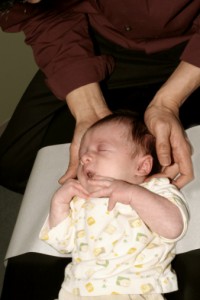Tummy tim e is an important and highly encouraged activity for infants. It strengthens the neck, upper back, and shoulder muscles and allows babies to enjoy their surroundings in a new way. According to physical therapists at Flushing Hospital, tummy time is also very crucial in the development of newborns and infants with torticollis.
e is an important and highly encouraged activity for infants. It strengthens the neck, upper back, and shoulder muscles and allows babies to enjoy their surroundings in a new way. According to physical therapists at Flushing Hospital, tummy time is also very crucial in the development of newborns and infants with torticollis.
Torticollis, also known as “twisted neck”, is a condition in which the head is tilted toward one side and the chin is elevated and turned toward the opposite side. It is commonly present at birth or can take up to three months to develop. Torticollis is believed to be a result of cramping in the uterus or abnormal positioning of the fetus.
“We don’t know exactly why some infants develop torticollis and others don’t,” explained Flushing Hospital Physical Therapist Dakshesh Sanghavi. “However, we do know that tightness of the neck muscle due to stiffness makes it difficult for a baby to turn their neck.”
Though infants with torticollis can reach their developmental milestones like most babies, when participating in activities that involve turning their neck, babies with torticollis might:
- tilt their head in one direction more than the other side.
- prefer looking at you over one shoulder instead of turning to follow you with his or her eyes.
- have difficulty breastfeeding on one side or prefers one breast only.
- work hard to turn toward you and becomes frustrated when unable to turn his or her head.
- develop a flat head or a small neck lump (similar to a knot in a tense muscle).
“Torticollis appears to be a very painful condition, but it usually is not,” said Mr. Sanghavi. “Although babies may have some pain when being stretched, the consequences of not treating the condition are much more serious.”
If torticollis is left untreated, babies and infants can develop scoliosis and/or impaired visual tracking. These problems can lead to developmental delays.
How to Treat Torticollis
The most effective treatment for babies diagnosed with torticollis is physical therapy. Physical therapy is aimed at helping babies and infants develop a full range of motion in their neck, arms, and shoulders, and increasing the strength of muscles surrounding their head and neck so that they can reach developmental milestones, such as rolling and crawling.
Physical therapy can range from simple neck stretching exercises to more intensive treatment. Mr. Sanghavi recommends that parents continually encourage their baby to turn their head in both directions. He recommends the following exercises:
- Encourage tummy time several times throughout the day for 10 to 15 minutes per session. When doing so, position the baby’s head away from you so that they have to turn to face you.
- Offer the bottle or breast in a way that encourages your baby to turn away from their favored side.
- Put your baby to sleep on his/her back and position him/her in a way that he/she will actively turn toward the opposite side. This will enable the tightened muscles to be stretched toward the opposite side.
- Draw your baby’s attention with toys and sounds to make him or her turn in both directions.
If you suspect your infant may have torticollis and you would like to schedule an appointment with a Flushing Hospital pediatrician, please call 718-670-5515.
All content of this newsletter is intended for general information purposes only and is not intended or implied to be a substitute for professional medical advice, diagnosis or treatment. Please consult a medical professional before adopting any of the suggestions on this page. You must never disregard professional medical advice or delay seeking medical treatment based upon any content of this newsletter. PROMPTLY CONSULT YOUR PHYSICIAN OR CALL 911 IF YOU BELIEVE YOU HAVE A MEDICAL EMERGENCY.
